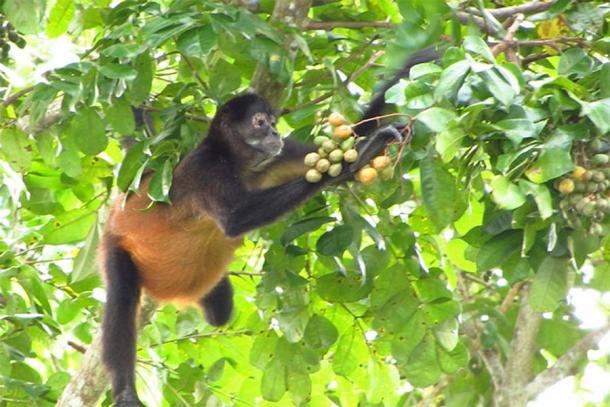When Dr. Robert Dudley of the University of California, Berkeley, proposed a hypothesis in 2000, and then published a book called ‘ The Drunken Monkey: Why We Drink and Abuse Alcohol’ on the same topic in 2014, the scientific community initially found his claims to be a bit farfetched. Called the ‘drunken monkey hypothesis’, he argued that the human attraction to ethanol emerges from our distant cousins’ (and ancestors’) love for ripe and fermenting fruit. Now, a new study published in the Royal Society Open Science agrees with Dudley’s alcohol consumption hypothesis.
Yeast and Ethanol: A Match Made in Fruit
Led by primatologist and anthropologist Christina Campbell of California State University, Northridge (CSUN), and her graduate student Victoria Weaver, the researchers collected fruit eaten and discarded by black handed spider monkeys , also known as the Ateles geoggroyi , in Panama. Dudley’s two and a half decades long research formed the theoretical backbone of their experiments with our tree dwelling cousins. He was also a consulting researcher on this.

The study of spider monkeys by CSUN anthropology professor Christina J. Campbell and graduate student Victoria Weaver sheds light on the theory that the human inclination to drink alcohol may have its roots in our ancient ancestors’ affinity to consume fruit so ripe that it had fermented enough to create ethanol (Victoria Weaver/ CSUN)
They found that the alcohol concentration in the fruit ranged between one and two percent by volume, as per a report in Earth. This was the result of a by-product of natural fermentation caused by yeast that consume the sugar in ripening fruits. The urine from the same monkeys displayed ‘secondary metabolites’ of alcohol, suggesting that the alcohol in the fruit was being used as a fuel for energy.
“For the first time, we have been able to show, without a shadow of a doubt, that wild primates, with no human interference, consume fruit-containing ethanol. This is just one study, and more need to be done, but it looks like there may be some truth to that ‘drunken monkey’ hypothesis – that the proclivity of humans to consume alcohol stems from a deep-rooted affinity of frugivorous (fruit-eating) primates for naturally-occurring ethanol within ripe fruit,” says Campbell.
Incidentally, indigenous populations in the southern and central Americas used fruit from the jobo tree for centuries to brew their local beer, chicha, a fermented alcoholic beverage. Incidentally jobo was a dominant part of the spider monkey’s diets as well.
“Given that positive selection on those genes encoding for ethanol catabolism has been substantial among fruit and nectar consuming mammalian species more generally, the natural consumption of fermented carbohydrates is likely to be more widespread than is currently realized,” the authors write.
Sobering Reality: No Drunkenness
However, Professor Dudley believes that monkeys probably do not feel the inebriating effects of alcohol that human beings go gaga about, though they do derive some sort of psychological benefit and satisfaction from it. “They’re probably not getting drunk, because their guts are filling before they reach inebriating levels,” he added.
This is probably due to derivation of some anti-microbial benefit within food that is being consumed, or it is entirely possible that the yeast and the microbes together are causing the fruit to ‘predigest’. The early primate desire for high calorie intake through fruit was thus hardwired into our DNA, which explains the proclivity towards ethanol-laden fruit, which is high on calories. Over time, this developed into a hedonic effect acquired from repeatedly finding ethanol in fruit, causing a cycle of consumption and calories to repeat itself.
“The study is a direct test of the drunken monkey hypothesis,” added Professor Dudley. “Part one, there is ethanol in the food they’re eating, and they’re eating a lot of fruit. Then, part two, they’re actually metabolizing alcohol – secondary metabolites, ethyl glucuronide, and ethyl sulfate are coming out in the urine. What we don’t know is how much of it they’re eating and what the effects are behaviorally and physiologically. But it’s confirmatory.”
Fruits that had no evidence of consumption were rejected either on the basis of smell, or texture (palpation), and visual appearance but a blind spot does exist – accidental dislodgement at the time of foraging, which this study cannot yet resolve.
Due to the easy over-the-counter availability of ethanol in the form of alcohol today, without any pulp or weight attached, it has become an easily indulgent and hedonistic pleasure, but this carries serious health consequences. Such a study would help understand behaviors and triggers that prompt alcohol excess and abuse. “Excessive consumption of alcohol, as with diabetes and obesity, can then be viewed conceptually as a disease of nutritional excess,” concluded Campbell.
Top image: A monkey drinks from a can of beer, representing the study finding that human alcohol consumption relates to a primal draw to the ethanol in fruits. Source: michalcbf6 / Adobe Stock
By Sahir Pandey
Related posts:
Views: 0
 RSS Feed
RSS Feed
















 April 8th, 2022
April 8th, 2022  Awake Goy
Awake Goy  Posted in
Posted in  Tags:
Tags: 
















